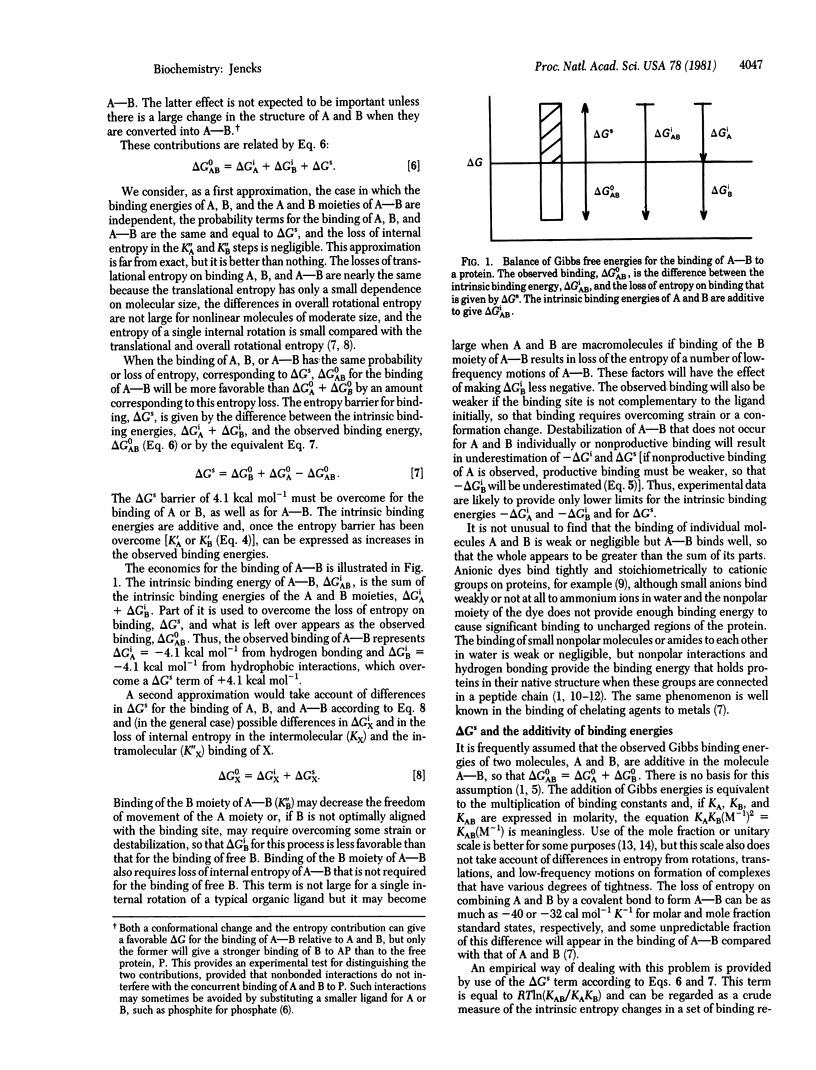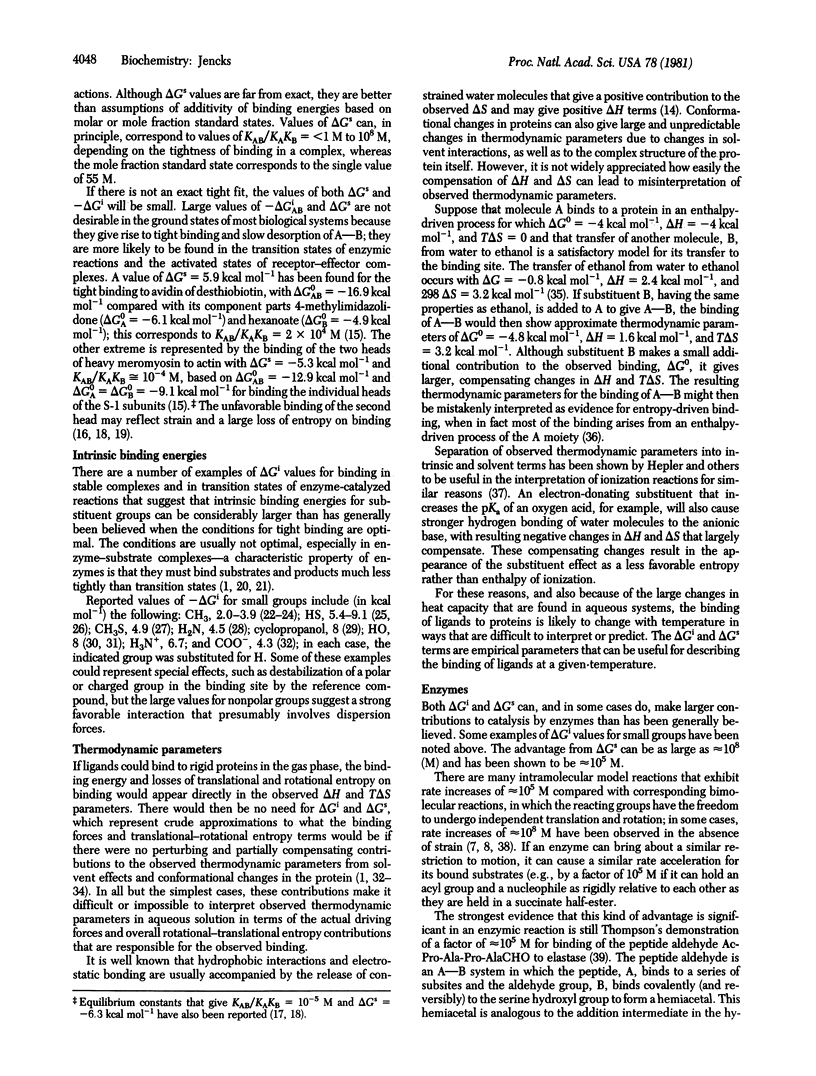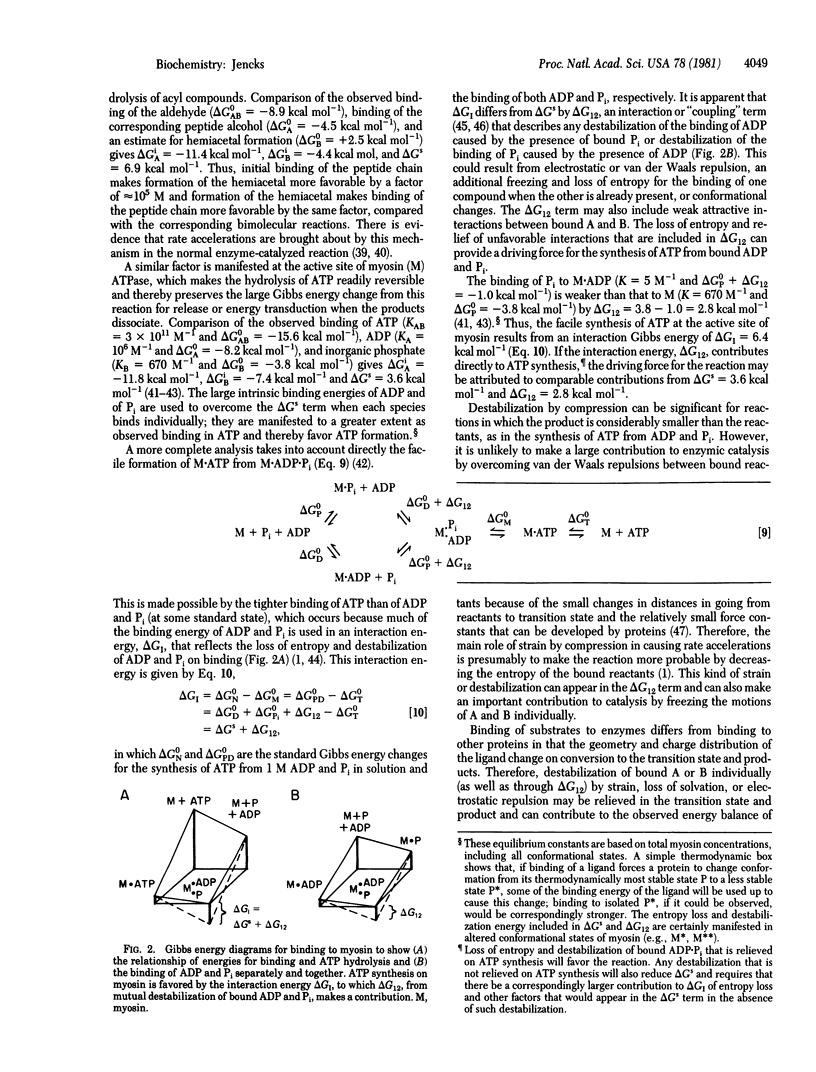Abstract
It can be useful to describe the Gibbs free energy changes for the binding to a protein of a molecule, A—B, and of its component parts, A and B, in terms of the “intrinsic binding energies” of A and B, ΔGAi and ΔGBi, and a “connection Gibbs energy,” ΔGs that is derived largely from changes in translational and rotational entropy. This empirical approach avoids the difficult or insoluble problem of interpreting observed ΔH and TΔS values for aqueous solutions. The ΔGi and ΔGs terms can be large for binding to enzymes and other proteins.
Keywords: proteins, ligands, entropy, enzymes
Full text
PDF




Selected References
These references are in PubMed. This may not be the complete list of references from this article.
- Bagshaw C. R., Trentham D. R. The characterization of myosin-product complexes and of product-release steps during the magnesium ion-dependent adenosine triphosphatase reaction. Biochem J. 1974 Aug;141(2):331–349. doi: 10.1042/bj1410331. [DOI] [PMC free article] [PubMed] [Google Scholar]
- Blanquet S., Fayat G., Poiret M., Waller J. P. The mechanism of action of methionyl-tRNA synthetase from Escherichia coli. Inhibition by adenosine and 8-aminoadenosine of the amino-acid activation reaction. Eur J Biochem. 1975 Feb 21;51(2):567–571. doi: 10.1111/j.1432-1033.1975.tb03957.x. [DOI] [PubMed] [Google Scholar]
- Bode W. The transition of bovine trypsinogen to a trypsin-like state upon strong ligand binding. II. The binding of the pancreatic trypsin inhibitor and of isoleucine-valine and of sequentially related peptides to trypsinogen and to p-guanidinobenzoate-trypsinogen. J Mol Biol. 1979 Feb 5;127(4):357–374. doi: 10.1016/0022-2836(79)90227-4. [DOI] [PubMed] [Google Scholar]
- Crothers D. M., Metzger H. The influence of polyvalency on the binding properties of antibodies. Immunochemistry. 1972 Mar;9(3):341–357. doi: 10.1016/0019-2791(72)90097-3. [DOI] [PubMed] [Google Scholar]
- Currier S. F., Mautner H. G. Evidence for a thiol reagent inhibiting choline acetyltransferase by reacting with the thiol group of coenzyme A forming a potent ingibitor. Biochem Biophys Res Commun. 1976 Mar 22;69(2):431–436. doi: 10.1016/0006-291x(76)90540-4. [DOI] [PubMed] [Google Scholar]
- Fersht A. R., Dingwall C. An editing mechanism for the methionyl-tRNA synthetase in the selection of amino acids in protein synthesis. Biochemistry. 1979 Apr 3;18(7):1250–1256. doi: 10.1021/bi00574a021. [DOI] [PubMed] [Google Scholar]
- Fersht A. R., Dingwall C. Cysteinyl-tRNA synthetase from Escherichia coli does not need an editing mechanism to reject serine and alanine. High binding energy of small groups in specific molecular interactions. Biochemistry. 1979 Apr 3;18(7):1245–1249. doi: 10.1021/bi00574a020. [DOI] [PubMed] [Google Scholar]
- Goody R. S., Hofmann W., Mannherz G. H. The binding constant of ATP to myosin S1 fragment. Eur J Biochem. 1977 Sep;78(2):317–324. doi: 10.1111/j.1432-1033.1977.tb11742.x. [DOI] [PubMed] [Google Scholar]
- Green N. M. Avidin. Adv Protein Chem. 1975;29:85–133. doi: 10.1016/s0065-3233(08)60411-8. [DOI] [PubMed] [Google Scholar]
- Greene L. E., Eisenberg E. The binding of heavy meromyosin to F-actin. J Biol Chem. 1980 Jan 25;255(2):549–554. [PubMed] [Google Scholar]
- Highsmith S. Heavy meromyosin binds actin with negative cooperativity. Biochemistry. 1978 Jan 10;17(1):22–26. doi: 10.1021/bi00594a004. [DOI] [PubMed] [Google Scholar]
- Holler E., Rainey P., Orme A., Bennett E. L., Calvin M. On the active site topography of isoleucyl transfer ribonucleic acid synthetase of Escherichia coli B. Biochemistry. 1973 Mar 13;12(6):1150–1159. doi: 10.1021/bi00730a021. [DOI] [PubMed] [Google Scholar]
- Jencks W. P. Binding energy, specificity, and enzymic catalysis: the circe effect. Adv Enzymol Relat Areas Mol Biol. 1975;43:219–410. doi: 10.1002/9780470122884.ch4. [DOI] [PubMed] [Google Scholar]
- Jencks W. P. The utilization of binding energy in coupled vectorial processes. Adv Enzymol Relat Areas Mol Biol. 1980;51:75–106. doi: 10.1002/9780470122969.ch2. [DOI] [PubMed] [Google Scholar]
- KAUZMANN W. Some factors in the interpretation of protein denaturation. Adv Protein Chem. 1959;14:1–63. doi: 10.1016/s0065-3233(08)60608-7. [DOI] [PubMed] [Google Scholar]
- Larsen J. W. Entropy contributions to rate accelerations of intramolecular reactions in water vs non-structured solvents. Biochem Biophys Res Commun. 1973 Feb 5;50(3):839–845. doi: 10.1016/0006-291x(73)91321-1. [DOI] [PubMed] [Google Scholar]
- Lumry R., Rajender S. Enthalpy-entropy compensation phenomena in water solutions of proteins and small molecules: a ubiquitous property of water. Biopolymers. 1970;9(10):1125–1227. doi: 10.1002/bip.1970.360091002. [DOI] [PubMed] [Google Scholar]
- Margossian S. S., Lowey S. Substructure of the myosin molecule. IV. Interactions of myosin and its subfragments with adenosine triphosphate and F-actin. J Mol Biol. 1973 Mar 5;74(3):313–330. doi: 10.1016/0022-2836(73)90376-8. [DOI] [PubMed] [Google Scholar]
- Page M. I., Jencks W. P. Entropic contributions to rate accelerations in enzymic and intramolecular reactions and the chelate effect. Proc Natl Acad Sci U S A. 1971 Aug;68(8):1678–1683. doi: 10.1073/pnas.68.8.1678. [DOI] [PMC free article] [PubMed] [Google Scholar]
- Palmer J. L., Abeles R. H. The mechanism of action of S-adenosylhomocysteinase. J Biol Chem. 1979 Feb 25;254(4):1217–1226. [PubMed] [Google Scholar]
- Peller L. Segmental flexibility in the myosin molecule: evidence from binding studies of myosin fragments with actin. J Supramol Struct. 1975;3(2):169–174. doi: 10.1002/jss.400030210. [DOI] [PubMed] [Google Scholar]
- Rappaport H. P. Evaluation of group contributions to ligand binding. J Theor Biol. 1979 Jul 21;79(2):157–165. doi: 10.1016/0022-5193(79)90244-3. [DOI] [PubMed] [Google Scholar]
- Ray W. J., Jr, Long J. W., Owens J. D. An analysis of the substrate-induced rate effect in the phosphoglucomutase system. Biochemistry. 1976 Sep 7;15(18):4006–4017. doi: 10.1021/bi00663a015. [DOI] [PubMed] [Google Scholar]
- Riceberg L. J., Vunakis H. V. Determination of N,N-dimethylindolealkylamines in plasma, blood and urine extracts by radioimmunoassay and high pressure liquid chromatography. J Pharmacol Exp Ther. 1978 Jul;206(1):158–166. [PubMed] [Google Scholar]
- SUSI H., TIMASHEFF S. N., ARD J. S. NEAR INFRARED INVESTIGATION OF INTERAMIDE HYDROGEN BONDING IN AQUEOUS SOLUTION. J Biol Chem. 1964 Sep;239:3051–3054. [PubMed] [Google Scholar]
- Stubbe J., Abeles R. H. Mechanism of action of enolase: effect of the beta-hydroxy group on the rate of dissociation of the alpha-carbon-hydrogen bond. Biochemistry. 1980 Nov 25;19(24):5505–5512. doi: 10.1021/bi00565a007. [DOI] [PubMed] [Google Scholar]
- Taylor E. W. Mechanism of actomyosin ATPase and the problem of muscle contraction. CRC Crit Rev Biochem. 1979;6(2):103–164. doi: 10.3109/10409237909102562. [DOI] [PubMed] [Google Scholar]
- Thompson R. C., Bauer C. A. Reaction of peptide aldehydes with serine proteases. Implications for the entropy changes associated with enzymatic catalysis. Biochemistry. 1979 Apr 17;18(8):1552–1558. doi: 10.1021/bi00575a026. [DOI] [PubMed] [Google Scholar]
- Thompson R. C. Binding of peptides to elastase: implications for the mechanism of substrate hydrolysis. Biochemistry. 1974 Dec 31;13(27):5495–5501. doi: 10.1021/bi00724a007. [DOI] [PubMed] [Google Scholar]
- Trentham D. R., Eccleston J. F., Bagshaw C. R. Kinetic analysis of ATPase mechanisms. Q Rev Biophys. 1976 May;9(2):217–281. doi: 10.1017/s0033583500002419. [DOI] [PubMed] [Google Scholar]
- WYMAN J., Jr LINKED FUNCTIONS AND RECIPROCAL EFFECTS IN HEMOGLOBIN: A SECOND LOOK. Adv Protein Chem. 1964;19:223–286. doi: 10.1016/s0065-3233(08)60190-4. [DOI] [PubMed] [Google Scholar]
- Wiseman J. S., Tayrien G., Abeles R. H. Kinetics of the reaction of cyclopropanone hydrate with yeast aldehyde dehydrogenase: a model for enzyme--substrate interaction. Biochemistry. 1980 Sep 2;19(18):4222–4231. doi: 10.1021/bi00559a013. [DOI] [PubMed] [Google Scholar]


